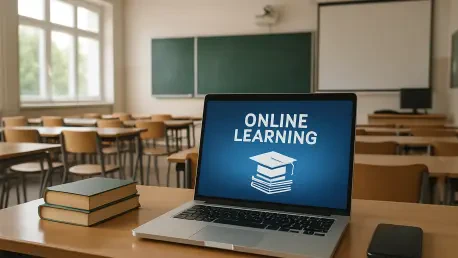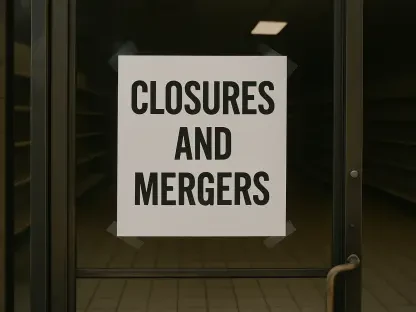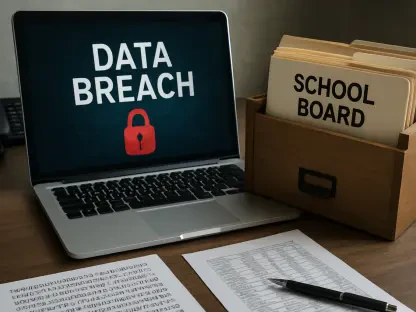In an era where technology permeates every facet of life, the realm of education stands at a pivotal crossroads, grappling with a fundamental question about the future of learning environments. The meteoric rise of online learning platforms, propelled by rapid advancements and catalyzed by global events such as the pandemic, has transformed homes, cafes, and even public transit into virtual classrooms, challenging the long-standing dominance of traditional brick-and-mortar schools. This seismic shift brings to light a pressing debate: can digital education fully supplant the conventional classroom experience, or does it merely serve as a complement to the irreplaceable elements of in-person learning? Flexibility, accessibility, and innovation are often touted as hallmarks of online education, yet they are weighed against the profound value of face-to-face interaction, structured environments, and social development that physical schools provide. As educational institutions worldwide navigate this evolving landscape, the tension between embracing digital tools and preserving traditional methods becomes increasingly evident. This exploration seeks to unpack the multifaceted dimensions of the debate, delving into the strengths and limitations of online platforms while considering whether they can truly stand as a replacement for the time-tested classroom model. The stakes are high, as the outcome of this shift could redefine how future generations learn, interact, and prepare for the world ahead.
Unprecedented Shift to Digital Education
The transition to digital education has been a transformative force, reshaping how knowledge is accessed and delivered across the globe. What once began as supplementary computer labs in schools has evolved into a near-universal reliance on smartphones and laptops as primary learning tools for students of all ages. The urgency of global disruptions, such as the pandemic, accelerated this change, compelling educational institutions to adopt online formats almost overnight. Even as physical classrooms reopen, many schools have retained virtual options, reflecting a broader acceptance of technology’s role in education. This rapid pivot showcases the adaptability of digital platforms but also underscores the challenges of maintaining quality and engagement in a virtual space. The shift has sparked curiosity about whether online learning could become the norm, prompting a closer examination of its potential to rival traditional settings.
Beyond the speed of adoption, the implications of this digital surge reveal a complex interplay between innovation and tradition. Schools now face the task of integrating technology without losing the essence of structured, in-person learning environments that have long been the bedrock of education. While online platforms offer a glimpse into a future where learning transcends physical boundaries, they also expose gaps in readiness—be it through inconsistent technological infrastructure or varying levels of student preparedness for self-directed study. This duality suggests that while the shift to digital education is revolutionary, it is not without significant hurdles that must be addressed to determine its viability as a full replacement for conventional classrooms.
Advantages of Digital Learning Platforms
One of the most compelling arguments for online learning lies in its ability to offer unmatched flexibility to students from diverse backgrounds. Whether it’s a high school athlete catching up on lessons after practice or a working adult pursuing further education, digital platforms allow learning to occur at a pace and time that suits individual needs. Beyond scheduling freedom, adaptive technologies provide personalized experiences, tailoring content to address specific strengths and weaknesses through real-time feedback mechanisms. Additionally, the cost-effectiveness of online education—reducing expenses for commuting, materials, and even infrastructure for schools—makes it an appealing option for both families and institutions. Access to a vast array of global resources further enhances the appeal, positioning digital learning as a formidable contender in the educational arena.
However, these advantages are not without their nuances, as the effectiveness of online learning often hinges on factors beyond the technology itself. Flexibility, while empowering, requires a level of self-discipline that not every student possesses, potentially leading to inconsistent outcomes. Personalization tools, though innovative, may lack the depth of guidance a teacher provides in a physical setting, sometimes leaving learners struggling to navigate complex topics. Moreover, while cost savings are a clear benefit, they don’t always guarantee a high-quality experience if investments in content and support systems are inadequate. These considerations highlight that while digital platforms bring substantial benefits, their success as an alternative to traditional classrooms depends on addressing these underlying challenges.
Limitations Hindering Online Education
Despite the promise of digital learning, significant obstacles stand in the way of it fully replacing traditional classrooms. A primary concern is the prevalence of distractions in virtual environments, where students often grapple with the lure of social media, games, and other non-educational content on their devices. Screen fatigue also emerges as a notable issue, with prolonged exposure to digital interfaces causing physical and mental strain that can diminish focus and retention. These factors disrupt the learning process, raising doubts about the sustainability of online education as a standalone model when compared to the more controlled atmosphere of a physical classroom where such distractions can be better managed.
Equally pressing is the issue of equity, which poses a formidable barrier to the universal adoption of online learning platforms. Not all students have access to reliable high-speed internet, modern devices, or quiet spaces conducive to studying, with disparities often falling along socioeconomic lines. This digital divide means that while some learners seamlessly engage with virtual education, others are left struggling to keep up, exacerbating existing educational inequalities. Efforts to mitigate these gaps, such as government-funded device programs or community internet initiatives, are underway but remain insufficient in scale and reach. Until these disparities are adequately addressed, the vision of online learning as a complete substitute for traditional classrooms remains out of reach for many, underscoring a critical limitation.
Vital Importance of Educators
Amid concerns that technology might diminish the role of educators, their significance in both online and traditional settings remains paramount. In virtual environments, teachers adapt by shifting from conventional lecturers to facilitators, leveraging digital tools to foster engagement and provide tailored support to students navigating remote learning. Their ability to interpret nuanced needs—whether through a student’s tone during a video call or a question in a chat—ensures that education retains a human touch, even in a digital space. This evolution demonstrates that far from being replaced, educators are redefining their roles to meet the demands of a changing landscape, proving indispensable to the learning process.
Particularly for younger students, the physical presence of teachers offers benefits that virtual interactions struggle to replicate. In-person guidance provides immediate feedback through body language, tone, and direct interaction, elements often lost in online formats where communication can feel detached. This is especially crucial in early education, where social and emotional development are as important as academic progress, and a teacher’s encouragement can make a lasting impact. While technology enhances access and delivery, it cannot fully substitute the mentorship and connection that educators bring to a physical classroom. This enduring value suggests that any future educational model must prioritize the integration of teachers, regardless of the platform, to ensure a balanced and effective learning experience.
Blending the Best of Both Worlds
As the debate over online versus traditional education unfolds, hybrid learning models are gaining traction as a balanced solution that harnesses the strengths of both approaches. These systems combine digital content delivery—such as pre-recorded lectures or online modules—with in-person activities like group discussions and hands-on projects conducted in physical classrooms. This approach allows students to benefit from the flexibility of accessing materials at their convenience while still engaging in collaborative, face-to-face experiences that foster critical thinking and teamwork. Hybrid models also reduce logistical burdens like daily commuting, offering a practical compromise that has garnered positive feedback from students, parents, and educators alike.
The appeal of hybrid systems extends beyond convenience, as they address some of the shortcomings inherent in fully online or fully traditional formats. By reserving classroom time for interactive and experiential learning, these models ensure that social bonds and spontaneous exchanges—key components of education—are not lost to digital isolation. Meanwhile, the online component provides access to a broader range of resources and accommodates diverse learning styles through customizable content. This synergy suggests that rather than a complete overhaul, the future of education may lie in integration, where digital tools enhance rather than replace the traditional classroom. As schools experiment with these frameworks, hybrid learning stands out as a promising path toward a more adaptable and inclusive educational system.
Social Bonds in Physical Spaces
A critical dimension often overlooked in the push for online learning is the role of traditional classrooms in fostering social and emotional growth. Schools serve as more than just academic hubs; they are environments where students develop essential life skills through peer interactions, learning to navigate conflicts, build empathy, and form lasting relationships. Face-to-face engagement offers spontaneous moments—whether a shared laugh or an impromptu debate—that shape personal development in ways that virtual platforms struggle to emulate. This unique aspect of physical classrooms raises concerns about the long-term impact of a fully digital education on students’ ability to connect with others.
While online learning attempts to bridge the social gap through features like virtual breakout rooms and discussion forums, these tools often lack the depth and immediacy of in-person exchanges. Digital interactions can feel scripted or constrained by technology, missing the organic nature of a classroom conversation where non-verbal cues play a significant role in communication. For many students, especially those in formative years, the absence of a physical community could hinder the development of interpersonal skills crucial for future success. This limitation underscores the notion that while online platforms excel in delivering content, they cannot fully replicate the social fabric woven in traditional schools, suggesting a need for balance in any educational model moving forward.
Addressing the Digital Divide
Perhaps the most formidable obstacle to online learning replacing traditional classrooms is the persistent issue of equity and access to technology. High-speed internet, up-to-date devices, and dedicated study spaces are not universally available, with disparities often most pronounced among students from lower-income households or rural areas. These gaps mean that while some learners engage effortlessly with digital education, others face significant barriers, unable to participate fully due to unreliable connections or outdated equipment. This digital divide risks deepening educational inequalities, turning online learning into a privilege rather than a right, and challenging the notion of it as a viable universal replacement for physical schools.
Efforts to close this gap, such as public Wi-Fi initiatives, subsidized device programs, and partnerships between schools and tech companies, are gaining momentum but remain uneven in their impact. Without comprehensive strategies to ensure that every student has the necessary tools and environment for online learning, the shift to digital platforms could exacerbate existing achievement disparities rather than alleviate them. Addressing this challenge requires not only investment in infrastructure but also policies that prioritize inclusivity, ensuring that technological advancements benefit all learners equally. Until these inequities are resolved, the dream of online education fully supplanting traditional classrooms will remain incomplete, highlighting the need for systemic change alongside technological innovation.
Shaping the Future of Learning
Reflecting on the journey of educational transformation, it becomes clear that online learning platforms have carved out a significant space in the academic world, offering flexibility and innovation that traditional classrooms sometimes struggle to match. The rapid adaptation to digital tools during global challenges showcased their potential, while the enduring value of in-person interaction reminded stakeholders of what physical schools uniquely provide. Teachers have adapted remarkably, proving their indispensable role across formats, and hybrid models have emerged as a thoughtful compromise, blending the best of both worlds. Yet, persistent inequities in access cast a shadow over the vision of a fully digital future, as not all students can equally engage with these advancements.
Looking ahead, the path forward lies in actionable integration rather than outright replacement, ensuring that online tools enhance traditional methods without leaving any learner behind. Investments in bridging the digital divide must accelerate, with targeted initiatives to provide resources to underserved communities over the coming years. Schools should continue refining hybrid frameworks, tailoring them to diverse needs while preserving social interaction as a core component of education. Policymakers, educators, and technologists must collaborate to build an inclusive system where choice and adaptability define learning, ensuring that the evolution of education prioritizes equity and human connection alongside innovation.









